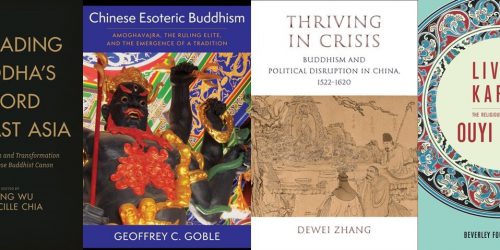Interview with A. Azfar Moin, author of The Millennial Sovereign
The following is an interview with A. Azfar Moin, author of The Millennial Sovereign: Sacred Kingship and Sainthood in Islam
Question: “The Millennial Sovereign” sounds like a Christian theme. What does it have to do with Islamic kingship?
A. Azfar Moin: The Mughal emperors of sixteenth and seventeenth century India–of Taj Mahal fame–were also avid collectors of Christian art. They even invited Jesuit missions to discuss the Bible. At first, the Catholic priests were delighted that such powerful Muslim kings were attracted to Christianity, but they eventually realized that their hosts were more interested in the millennium. The first millennium of Islam occurred at the end of the sixteenth century. The Mughals used this religiously charged moment to style themselves as saintly and messianic sovereigns. They called their queens “The Mary of the Age” and “Of the Stature of Mary.” This didn’t mean that they had turned Christian, but that they were Jesus-like in their sacredness.
Q: How do saints and sainthood fit into the picture?
A.A.M.: All cultures cast their kings in a sacred aura, as beings set apart from ordinary existence. But this sacredness is always expressed in a historically specific style. In the early modern era, the style of Muslim kingship was inspired by, among other things, Sufi saints. Fifteenth and sixteenth centuries saw the age of sainthood in Islam. Sufi brotherhoods organized around saint cults were everywhere. Sufi saint shrines had become grand centers of wealth and power. Sufi families acted as kingmakers. This is why Muslim rulers across Iran, Central Asia, and India borrowed symbols and rites of sainthood. To put it simply, if saints accepted devotees, kings enrolled disciples. If Sufis led messianic uprisings, Muslim rulers fashioned themselves as holy saviors.
Q: This sounds like a very different type of Islam than we usually hear about? Where were the doctrinal sects of Islam, the Sunnis and Shias, and their traditional scholars, the ulama?
A.A.M.: Sunnis, Shias, and the ulama were all there. But they were subsumed by webs of Sufi and imperial patronage. Wealth, power, and status belonged to imperial dynasties and Sufi lineages. They were the ones who patronized learning and mobilized fighting men. Authority in early modern Islam was enshrined in the charismatic body of the saint, the king, and—at times—the saint-king. This development had something to do with the thirteenth-century Mongol conquests. The Mongols ruled over Muslim Asia for a century without converting to Islam. It their wake, dynastic law eclipsed the sharia and Sufi sainthood dominated doctrinal Islam. This was one reason that in the post-Mongol empires of Iran and India, charismatic sainthood and dynastic cults fused together in a new type of Muslim kingship.
Q: In the book, you give an intriguing account of how Muslim kings and saints used astrology, magic, and alchemy. What drew you to these occult traditions?
A.A.M.: When you look at the sources from this era—chronicles, lives of saints, epics, and even paintings—occult knowledge appears everywhere. The most famous fourteenth-century Muslim conqueror Timur, or “Tamburlaine the Great” as he was known in Europe, was revered by an astrological title, “Lord of Conjunction.” My point is that astrology and magic were not a mark of irrationality or just part of popular culture, but defined the worldviews of all social classes. This is similar to how mathematicians and scientists in Renaissance Europe tried to unlock the mysteries of the cosmos via astrological patterns and alchemical formulations. Magic, science, and religion were overlapping concepts. And, in fact, European Christians and Asian Muslims often used the same texts and techniques for deciphering the unknown. One of the shared questions that drove these intellectuals was who was going be the next world-conqueror, the next great saint, the expected Messiah.
Q: You mentioned the ritual use of painting and the sacred art of Muslim kings. Again, this seems a deviation from orthodox Islam. Can you comment on this?
A.A.M.: Painting and the aesthetic arts have long been part of Muslim courts. However, in early modern times we see distinctive ritual uses of the painted image. For instance, the Mughal emperors gave their disciples a coin-sized portrait of themselves. Courtiers kept this on their person, sometimes by wrapping it in their turban. Similarly, we have paintings that record the emperor’s dream and his miraculous abilities. These practices were akin to Sufi customs. Muslims of the time revered the relics of their saints, saw them in dreams, and meditated on their mental image. So, going back to my earlier remark, we see here a merger of imperial and saintly culture. This was the dominant culture. There were critics, but not with much influence.
Q: Why and when did these practices end? Why don’t we hear about them anymore?
A.A.M.: Eighteenth-century onward, European imperialism reshaped Muslim Asia. Muslim kings lost power. Muslim sainthood lost its primacy and survived in fragments of local cultures. Protestant and “scientific” critiques of Asian religions led to influential movements of “reform.” Muslim elites adopted Western enlightenment norms. With all this, our view of history changed. It became unfashionable to talk about the old ways of doing things, which were shunned as backward and degenerate. Such distaste is still very much with us. It must be overcome to see the cultural richness of this past.



